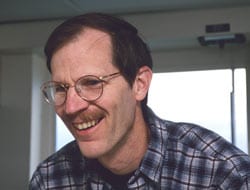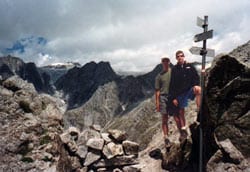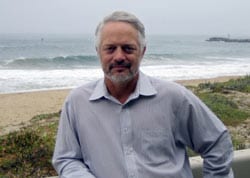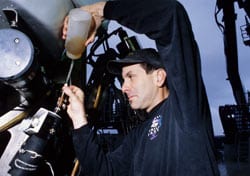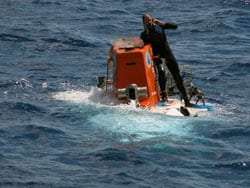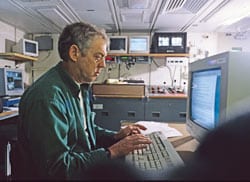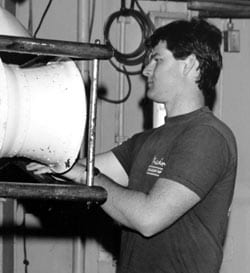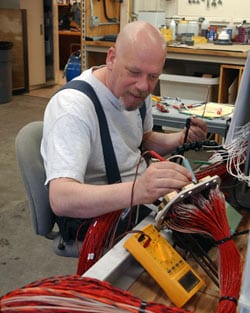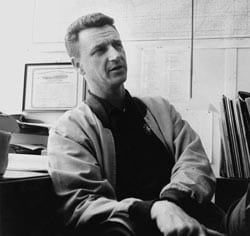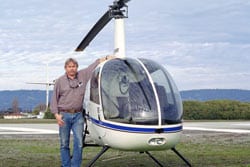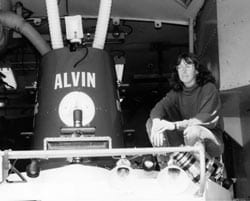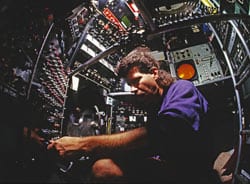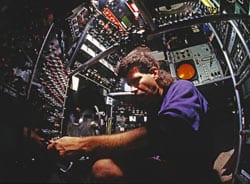
Life After Alvin
You can't keep former Alvin pilots down on the farm, once they've seen the seafloor
Bob Brown
Age 52
Alvin pilot from 1979 to 1982
Life after Alvin:
Brown returned to the U.S. Navy and spent 15 years in the submarine service commanding subs stationed in California, Hawaii, and Connecticut. After retiring in 1997 he returned to WHOI as an engineer with the Alvin group. He also requalified as an Alvin pilot, and participated on several expeditions. His current work includes managing the design and engineering of Alvin’s replacement vehicle, expected to be complete in 2009. During the summer he lives on his sailboat in Woods Hole. He spends the colder months in Niantic, Conn., with his wife and two daughters, ages 4 and 9. He has taken up soaring, a sport that involves riding winds in a motorless glider.
Memorable moment
“My first dive in a volcanic area of the seafloor off the Gulf of California. It amazed me to think that we were the first people to see these lava tubes located in a place that resembled the moon.”
IMAGE CAPTION: Bob Brown now manages the design and engineering of Alvin’s replacement vehicle, expected to be complete in 2009. (Woods Hole Oceanographic Institution photo)
Don Collasius
Age 48
Alvin pilot from 1982 to 1988
Life after Alvin:
“I left because I had two small daughters, ages 2 and 4, and my son was born the following year. I wanted to be a bigger part of their lives; it’s tough to be a baseball coach when you’re working on other side of world.” Collasius went to work as a manufacturer of oceanographic research equipment, and at the same time took night classes for his mechanical engineering degree. In 1994 he began work as an engineer at Onset Computer Corporation on Cape Cod, designing loggers, fixtures, and other equipment used by scientists and engineers. He lives in Rochester, Mass., with his wife and three teenage children.
Memorable moment:
“Geologists often wanted to sample rocks that were still connected to a seafloor feature. During one dive I pulled on a rock near the top of a 30-meter rock wall. This caused a small avalanche to fall into Alvin’s sample basket (mounted on the front of the submersible). Three hundred pounds of extra rocks quickly made me negatively buoyant. To get out of the fix, I backed off fast, spun around, thrusted full up, and made a reasonably soft landing on the seafloor. Then I emptied the sample basket of the excess rocks and proceeded with the dive. We caught it all on video. My boss was quite impressed.”
IMAGE CAPTION: Don Collasius, shown here with his son Don Alberto on a hiking trip in Italy, now works as an engineer at Onset Computer Corporation on Cape Cod. (Photo courtesy of Don Collasius)
Steve Etchemendy
Age 55
Alvin pilot from 1987 to 1989
Life afterAlvin:
In November 1989, Etchemendy began work with the Monterey Bay Aquarium Research Institute in California, where he continues to direct their marine operations group, including the operation of three research vessels, two remotely operated vehicles, and two autonomous underwater vehicles. He and his wife live in Carmel Valley, Calif., where he rafts rivers, runs, hikes, and bicycles. His has a grown son and daughter and one step-daughter.
Memorable moment:
“I always think of one of my first dives as a solo pilot, at an undersea volcano located off Acapulco in Mexico. I had surveyed up the flanks of the volcano, then came up over the lip and landed in this lake; it was a hard, frozen, flat plane of lava. Holes dotted the lake in a couple areas, where the lava had collapsed. The lights from the sub penetrated down into this gloom, and we could see these long columns of frozen lava. It was extremely spooky, like something out of The Lord of the Rings.
IMAGE CAPTION: Steve Etchemendy now directs marine operations group at the Monterey Bay Aquarium Research Institute in California. (Photo courtesy of Steve Etchemendy)
Steve Faluotico
Age 37
Alvin pilot from 1996 to 2000
Life after Alvin:
“I moved from Aspen, Colorado, to Woods Hole to work as an engineer in the Applied Ocean Physics & Engineering Department at WHOI. My hobbies include running and taking naps. I still try to ski, mountain bike, and get some adventure in now and then. I’m married to Stace Beaulieu, who works as a biologist at WHOI. We met on one of my last Alvincruises. She has a lot of energy, and I try to keep up with her.”
Memorable moment:
“We saw a shark feeding on a whale carcass on a dive off the coast of California. At one point the shark turned to look into Alvin’s view port and seemed to smile at me.”
IMAGE CAPTION: Steve Faluotico now works as an engineer in the Applied Ocean Physics & Engineering Department at WHOI. (Woods Hole Oceanographic Institution photo)
Phil Forte
Age 46
Alvin pilot from 2000 to 2004
Life after Alvin:
“I was a late bloomer; I didn’t join the Alvin group until I was 39 years old, and left last year. Since then I’ve been working at WHOI as a mechanical engineer with the remotely operated vehicle Jason. After spending so much time at sea, I’m now relearning what my hobbies are. I enjoy arts and entertainment, including movies, plays, and live music. I’m also delighted to be surrounded by plants and green things on shore.”
Memorable moment:
“I kept a personal log book of all my dives with the date, location, observers, and what we did. Looking back, one of my favorite dives was with Tim Shank and Rhian Waller, both scientists at WHOI. It was June 1, 2002, and we were on the Galápagos Rift. It was the 25th anniversary since scientists had discovered hydrothermal vents at the site, and initially there was a lot of frustration because we discovered that the site we intended to visit had been paved by lava. So on this dive with Tim and Rhian, we were exploring this crack in the seafloor. All of a sudden Tim saw clam shells, and we go a little more, and we’re in this huge clam bed that no one had seen before. Just acres of clams. We were so excited, we made up this song, to the tune of the “Green Acres” theme song, but our song went “Clam acres is the place to be…”.
IMAGE CAPTION: Phil Forte, shown here assisting with the recovery of Alvin, now works at WHOI as a mechanical engineer with the remotely operated vehicle Jason. (Photo courtesy Phil Forte)
Dudley Foster
Age 59
Alvin pilot from 1974 until he retired in 2006
Life after Alvin:
Foster, a mechanical engineering, came to Woods Hole 33 years ago looking for a job. “I applied for any job—janitor, whatever,” he said. “I was lucky enough to get a job as an engineering liaison. In those days, we were working on getting Alvin to the point where it was reliable enough for routine science operations. I was lucky enough to be here when many scientists were willing to take the professional and scientific risks to show that Alvin could be a valuable scientific research tool.” In 1975, a year after becoming an Alvin pilot, Foster was named expedition leader, a job that made him responsible for all the at-sea aspects of Alvin operations, including logistics for science research and certification and training of fellow pilots. He continues to work for the Alvin group and occasionally goes to sea. He has been married for 28 years, and has a grown son and daughter. He lives in East Falmouth, Mass.
Memorable moment:
“My first dive was one of my most memorable. It was my first dive in a submarine, other than the submarine ride at Disneyland. Surprisingly, there were many similarities in the sights and sounds.”
IMAGE CAPTION: Dudley Foster continues to work for the Alvin group and occasionally goes to sea to assist with research involving the sub. (Woods Hole Oceanographic Institution photo)
Bob Grieve
Age 41
Alvin pilot from 1990 to 1995
Life after Alvin:
Grieve went to work for the Massachusetts Institute of Technology as the operations manager for the school’s autonomous underwater vehicle laboratory. In May 1997 he co-founded Bluefin Robotics Corporation in Cambridge Mass., a company that builds and operates autonomous underwater vehicles used by oil, gas, military and science industries. Grieve is divorced, lives in Halifax, Mass., and is the father of four children, ages 1, 6, 13, and 17.
Memorable moment:
“Enduring scientist John Delaney’s singing and endless limericks on the ascent in Alvin after finding a hydrothermal vent field at the Juan de Fuca Ridge.
IMAGE CAPTION: Bob Grieve, shown here in the early 1990s, is the co-founder of Bluefin Robotics Corporation in Cambridge Mass., a company that builds and operates autonomous underwater vehicles used by oil, gas, military and science industries. (Woods Hole Oceanographic Institution photo)
Will Sellers
Age 48
Alvin pilot from 1982 to 1986
Life after Alvin:
“I loved being a young, macho-man submarine pilot. But I decided to leave the Alvin group shortly after piloting two dives to Titanic. Our mission in the sub was to photograph the wreck. I knew it was going to be hard to try to top that experience, and I was ready for something different. I wanted to stay working in science, so I learned how to operate ROVs (remotely operated vehicles). I like them better than manned submersibles because they are operational 24 hours a day from a ship; you don’t have to recharge batteries like you do on Alvin, or worry about getting people up because they need to eat or use the bathroom. Plus more people get to see what is happening, and discuss what’s going on. Today I am the chief pilot and expedition leader for the ROV Jasonoperations team at WHOI. We just finished three trips to the Lau Basin, and over Christmas and New Years we’ll be working offshore the Galápagos Islands.” Sellers lives in Falmouth, Mass., with his wife, a computer programmer at WHOI.
Memorable moment:
“Arriving on Titanic’s lifeboat deck in Alvin and seeing the spot where I knew hundreds of people had died.”
IMAGE CAPTION: Will Sellers is now the chief pilot and expedition leader for the ROV Jason operations team at WHOI. (Woods Hole Oceanographic Institution photo)
Larry Shumaker
Age 73
Alvin pilot from 1973 to 1978
Life after Alvin:
After leaving WHOI, Shumaker worked as a manager and engineer for various ocean technology-related companies in New Jersey, California, St. Croix, and Hawaii. His jobs included selling torpedo decoys to the Navy, managing an ocean buoy testing facility, and doing maintenance on submarines used by tourists. He now works part-time as a submersibles consultant. He lives with his wife in El Cajon, Calif. They have two daughters and nine grandchildren.
Memorable moment:
“I was a pilot in 1977, the year scientists first identified hydrothermal vents near the Galápagos Islands. I went down as a pilot about a week after they were located. I remember the shimmering water coming from the vents and the unusual animals that humans had never seen before. Of course, now scientists have identified many of these animals. But at the time it was all so weird and new. I felt like Alice in Wonderland.”
IMAGE CATPION: Larry Shumaker, shown here in the early 1960s, continues to work part time as a consultant for companies developing submersibles. (Photo courtesy of Larry Shumaker)
Tom Tengdin
Age 51
Alvin pilot from 1987 to 1991
Life after Alvin:
Tengdin and his wife, a geologist, landed jobs at Monterey Bay Aquarium Research Institute in Moss Landing, Calif. In 2001 he went to work at the Moss Landing Power Plant, where he did electronics repair. He now works for the Calpine Power Company in Watsonville, Calif., doing electric and computer maintenance for a plant that provides electricity to 30,000 households located south of San Francisco. Tengdin also serves as an active amateur radio operator, works as a reserve firefighter, and holds licenses to fly single engine airplanes and helicopters. “I’m one of the few people in the world certified to hover at plus—or minus—13,000 feet,” Tengdin said. He lives with his wife and 12-year-old daughter in Prunedale, Calif.
What he misses about being an Alvin pilot:
“The view out the windows. Video doesn’t capture the black smokers; when you’re down there among them, you can almost hear them roar.”
IMAGE CAPTION: Tom Tengdin, who holds licenses to fly single engine airplanes and helicopters, said that he is “one of the few people in the world certified to hover at plus—or minus—13,000 feet.” (Photo courtesy of Tom Tengdin)
Cindy Lee Van Dover
Age 51
Alvin pilot from 1989 to 1991
Life after Alvin:
“I made my last dive as a pilot in December 1991,” Van Dover wrote in her book The Octopus’s Garden: Hydrothermal Vents and Other Mysteries of the Deep Sea. “Although I loved diving…I knew my real career was in research.” Van Dover stayed at WHOI as a postdoctoral investigator in the Department of Marine Chemistry and Geochemistry until 1994. She then spent a year as a visiting scholar at Duke University’s School of the Environment, followed by work as the science director of the West Coast National Undersea Research Center and Research at the University of Alaska, Fairbanks. She was a faculty member of The College of William & Mary in Williamsburg, Virginia, for eight years until 2006, when she became director of the Duke University Marine Lab. Since leaving the Alvingroup, she has continued to participate in one or more Alvin dive series per year. She also uses the remotely operated vehicle Jason(most recently in Lau and Fiji Basins). She spends her free time restoring a Chesapeake Bay waterman’s house, including the garden.
What she misses about being an Alvin pilot:
”I miss the camaraderie of the group and the crew aboard the ship. I miss the adventure, the challenge, the sense of always being at the edge of the science.”
IMAGE CAPTION: Cindy Lee Van Dover, shown here in the early 1990s, is the only woman to have become an Alvin pilot. She is now director of the Duke University Marine Lab. (Woods Hole Oceanographic Institution photo)
Robert Lee “BLee” Williams
Age 44
Alvin pilot from 1993 to 2004
Life after Alvin:
Williams left the Alvin group to marry and move to Canada, where he and his wife both work at the University of New Brunswick, Saint John. His job as an electronics technician “often involves using skills gained during my time with WHOI,” he said. He lives in Quispamsis, a rural village in New Brunswick that requires driving to work through a dairy farm. He coaches youth and adult soccer teams and recently played a Scottish nobleman at a Shakespearean festival. “I got to have three sword fights on stage,” he said. He and his wife are expecting their first child in December.
What he misses about being an Alvin pilot:
“I loved showing people the seafloor. I loved crouching in the submarine and having the animals right outside the view ports, and watching people become so fired up about science. I also miss life on the ship. Don’t get me wrong; there is interpersonal stress that comes from locking people up on a ship for months at a time. But I liked being involved with a community that was focused on a single goal.”
IMAGE CAPTION: Robert Lee “BLee” Williams shown inside Alvin’s sphere. He now lives and works at a university in Canada. (Woods Hole Oceanographic Institution photo)
From the Series
Related Articles
- The story of a “champion” submersible
- Robots to the Rescue
- Who is Alvin and what are sea trials?
- 7 Places and Things Alvin Can Explore Now
- The story of “Little Alvin” and the lost H-bomb
- Meet the Alvin 6500 Team: Lisa Smith
- Overhaul to take Alvin to greater extremes
- Meet the Alvin 6500 Team: Rose Wall
- Racing an undersea volcano
See Also
- Alvin Pilots A tight-knit group with the 'right stuff' to guide a submersible on the seafloor. from Oceanus magazine
- 'Ever Get Scared in the Sub?' and Other Questions Interviews with the pilots who take Alvin to the deep. from Oceanus magazine
- What is the Alvin Training Program Like? A conversation with former Alvin pilot Anthony Tarantino. from Oceanus magazine

